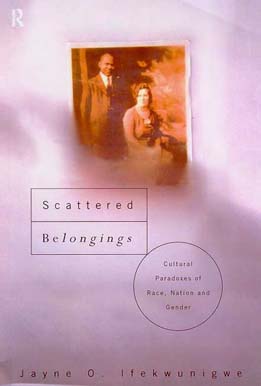
no 8. October 1998.
https://www.arts.uwa.edu.au/MotsPluriels/MP898sb.html
© Jayne O. Ifekwunigwe

|
CONTENTS
Illustrations Prologue Acknowledgements 1. Cracking the Coconut:Resisting Popular Folk Discourses on "Race," "Mixed Race" and Social Hierarchies 2. Returning(s):Relocating the Critical Feminist Auto- Ethnographer 3. Setting the Stage:Invoking the Griot(te)Traditions as Textual Strategies 4. Ruby 5. Similola 6. Akousa 7. Sarah 8. Bisi 9. Yemi 10. Let Blackness and Whiteness Wash Through: Competing Discourses on Bi-Racialization and the Compulsion of Genealogical Erasures Epilogue Select Bibiographies Index |
Scattered Belongings is a book with two major objectives. First,this text begins to redress the imbalance in British literature on "mixed race" theories and identities. Second,this book centralizes the everyday words of working class and middle class "mixed race" people in England. These narratives of "mixed race" identities challenge what it means to be both "Black" and English. This book is structured as a critical dialogue between cultural theories and personal/political testimonies. The main theory chapter traces the origins of the term "hybridity" back to its problematic beginnings in nineteenth century "race" science and especially evolutionary anthropology and critiques contemporary cultural theorizing on "hybridities" which reframes "race" as difference(s).
Drawing on personal narratives , I also show how , as storytellers, six contemporary "mixed race" women tangle with the twin torments of "Englishness" being exclusively associated with "Whiteness" as well as the presumption that one's designated "Blackness" automatically means one cannot truly belong in England. In general,their stories illustrate the ways in which across time and space, "mixed race" family histories are shaped by particular societies' views on "race", gender and sexuality.
Chapter one, Cracking the Coconut:Resisting Popular Folk Discourses on "Race", "Mixed Race" and Social Hierarchies offers a critique of "race" as a scientific concept,problematizes the ideas of both "biological" and "cultural hybridities",and discusses the ways in which these concepts influence theorizing on "mixed race". Chapter two, Returning(s): Relocating the Critical Feminist Auto- Ethnographer,introduces the reader to the author as a feminist auto-ethnographer and outlines the methodology of the research project. Chapter three,Setting the Stage:Invoking the Griot(te) Traditions as Textual Strategies,introduces the project participants and discusses current anthropological debates associated with objective truth and story telling. The Preamble:Could I Be a Part of Your Family?:Preliminary /Contextualizing Thoughts on Psychocultural Politics of Transracial Placements and Adoption engages with current debates about transracial fosterage and adoption.
In their own words, chapters four through nine tell the stories of six of the original twenty five project participants. Chapter ten, Let Blackness and Whiteness Wash Through:Competing Discourses on Bi-Racialization and the Compulsion of Genealogical Erasures, challenges conventional thinking which suggests that "mixed race" individuals must identify as "just Black". The Epilogue:Beginnings By Way Concluding Remarks, suggests that typologies of "race" and social hierarchies must be dismantled for social equalities to exist and persist.
This project provides an original template for present and future social science research on "critical mixed race" theories and identities in Britain and other pluralistic contexts. What makes this book unique is that it provides a measured balance of theoretical innovation on "race","mixed race" and social identities as well as representations of original narratives and testimonies with the methodological guide to replicate this research in other contexts. In general, this research builds an argument for the dismantling of "racial" classifications and the celebration of complex affiliations based on multiethnicities and transnationalities.
Back to
[the top of the page]
[the contents of this issue of MOTS PLURIELS]
[ Jayne O. Ifekwunigwe's article Re-invoking the Griotte tradition as a feminist textual strategy published in "Mots Pluriels"]